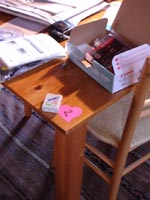
|
METHODOLOGY Thermal Comfort Assessment Thirty HOBO 4-channel dataloggers were placed at interior and exterior positions, in a zone from 24" to 36" above the floor, in the first and second stories of the house. Temperature and relative humidity were measured at 5-minute intervals from 1:00pm Friday, February 17 until 6:00pm Tuesday, February 21. One datalogger was placed over a heat register to indicate furnace function. Solar Resource Estimation Window measurements and plans were used to construct a Sketch-Up model of the house. Sketch-Up's shading feature was used to create images showing Feb 21st solar penetration. In addition, a solar transit was used to map the shading of the house by trees and buildings nearby. We measured the visible and infrared transmittance of the glazing of the windows and patio doors with a Licor Pyranometer, and we used the University of Oregon’s Solar Radiation Monitoring Laboratory website to determine incident solar energy on horizontal surfaces in Eugene in March. Finally, we calculated the actual solar resource, in Btu/d, available inside the Davis house due to solar penetration through the south glazing. Mass Investigation One ton of dark red paving bricks (360; approx. 0.70 solar absorption) were used to cover a large contiguous area on the living room floor during a second set of sunny early spring days. Thirty 4-channel Hobo dataloggers were used to monitor internal and external temperature and relative humidity both before and after placement of the pavers. |
|||

